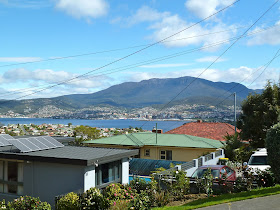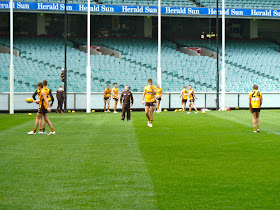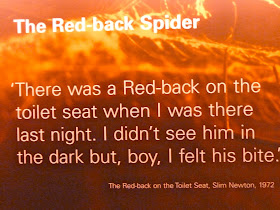I think the interpretation above is rather rude. My, more reasonable, understanding is that the map of Tassie looks like a pair of my unwashed shreddies.
 Left: The ferry. Quite a comfortable mode of transport. The ship left Melbourne Harbour at 1930hrs and arrived at Devonport on the north side of Tassie at 0600hrs next morning. The cost seemed to vary enormously, dependent on passenger bookings I suppose. My journey over, mostly spent asleep on a comfortable(ish) reclining seat, was $195, and coming back $95. To get a cabin would have cost a small fortune. The sea was calm, thankfully, and the ship boasted a good restaurant, a cheaper cafeteria and two smart bars. My only complaint, and I have to have one at least, was concerning another weird 'rule' they have on the sale of drink. I ordered a double whisky ( to make sure I slept well ). I was told "Sorry Sir, we can only sell singles. Ship's rules". "OK", said I "please give me two singles then". "Sorry mate, can't do that either. You have to bring your empty glass back and I can then sell you another". What wally thinks up these patronising and rather insulting regulations? There must be some odd, rather bossy, people in charge.
Left: The ferry. Quite a comfortable mode of transport. The ship left Melbourne Harbour at 1930hrs and arrived at Devonport on the north side of Tassie at 0600hrs next morning. The cost seemed to vary enormously, dependent on passenger bookings I suppose. My journey over, mostly spent asleep on a comfortable(ish) reclining seat, was $195, and coming back $95. To get a cabin would have cost a small fortune. The sea was calm, thankfully, and the ship boasted a good restaurant, a cheaper cafeteria and two smart bars. My only complaint, and I have to have one at least, was concerning another weird 'rule' they have on the sale of drink. I ordered a double whisky ( to make sure I slept well ). I was told "Sorry Sir, we can only sell singles. Ship's rules". "OK", said I "please give me two singles then". "Sorry mate, can't do that either. You have to bring your empty glass back and I can then sell you another". What wally thinks up these patronising and rather insulting regulations? There must be some odd, rather bossy, people in charge.
I spent the first night and next day in Launceston ( pronounced Launsesston ), about 50 miles south of Devonport. It is on the river Tamar and is a delightful place. Founded in 1808 by a chap called Lt. Col. William Paterson, it features many elegant 19th century buildings like this ( right ), the town hall. Also a 19th century umbrella shop called 'The Umbrella Shop' which has been owned by the same family since 1900. It has some 100 year old umbrellas on display. If you opened them I suspect they would disappear in a cloud of dust.There are several good wineries up the Tamar valley and the town itself is a clean, attractive and interesting place to wander around. I discovered an excellent ( I liked it anyway ) cabernet merlot wine called Velo. This small winery on the Tamar is owned by a chap who used to be a Tour de France standard bicyclist, hence the name. Sadly it is difficult to get it outside Tasmania. They sell it on the Ferry, and you can buy it by the bottle there ( at a big mark up price )....but you still can't have a large whisky.

There is at least one Oirish bear ( left ) next to the funeral director....or maybe part of. Not a bad hostelry, except the price of a beer was $10 and a modest portion of watery micro-waved Irish stew cost $19.50! Phew, enough to drive a man to drink. They did, however, show World Cup rugger matches. I may have mentioned before; this part of Oz shows little interest in rugby. All the other establishments were showing AFL matches.

There is a fantastic walk up the South Esk river, a tributary of the Tamar, called the Cataract Gorge. It is quite an energetic hike up some narrow hilly paths on the edge of a very sheer sided gorge and the views are pretty spectacular. This ( right ) is near the beginning looking back at Launceston and the river Tamar.

Left: A view up the gorge. This part of the world was one of the last refuges of the Tasmanian Tiger. It was hunted to extinction in the early part of the last century. The last known living Tiger died in captivity in 1936. They were thought to be a menace to livestock and dangerous, but were apparently surprisingly timid creatures. They had the body of a tall dog, smooth sandy coloured hair with black stripes over their hind quarters, a long tail and a dog-like head with long narrow jaws and pointy ears. There have supposedly been modern day sightings of them, but no-one has produced any photographic or other evidence. I expect they are about as common as the Loch Ness monster and there is, no doubt, a handsome prize for anyone who can find one. They are extinct.

.....not to be confused with the Tasmanian Devil ( right ). This is the size of a small dog and, to my eyes, rather an unattractive creature. They are carnivorous scavengers and, apparently, vicious little brutes. They are in serious decline due to the rampant spread of an infectious cancerous growth with grows on their heads, thought to be caused by inbreeding. There is a programme to breed healthy animals in captivity and restore the numbers. The Tassie Tourist Offices are trying to promote these animals as cuddly little things for visitors to go and gawp at. I didn't. Suggest you don't try to cuddle them if you value your fingers, or your throat.

About three miles up the gorge and cataracts you get to what is known as the first basin. This has a chairlift across it which is, we were told, the longest single span chairlift in the world at 308m/1010ft. This photo was taken from it. It struck me as being rather a flimsy affair and shook a bit. Before boarding for the return I overheard a radio conversation involving an extremely obese woman they were trying, with difficulty, to load on at the far side. I was worried it might collapse the whole thing. I passed her mid-basin. She took up both seats on her 'chair' and then overflowed a bit. I didn't dare wave at her in case she waved back and set up some catastrophic vibrations. We survived. The suspension footbridge at the far end of the basin is quite striking.

"Watch me wallabies' feed, mate, watch me wallabies' feed......they're a dangerous breed, mate, so watch me wallabies' feed"
This little chap was sitting at the end of the chairlift. He seemed very tame.

Left: Nothing spectacular here; just to give some idea of the general countryside on the bus journey down the centre of the island to Hobart. Lots of sheep and cattle farming and some fairly wild wide open spaces. We passed hamlets ( some just a scattering of bungalows off the road ) with names such as Epping Forest, Campbell Town, Tunbridge, Melton Mowbray, Kempton and Bagdad.
The real wild mountainous countryside is on the west side of the island which is mostly National Park land and very sparsely populated.

Right: A view of Hobart from the east with Mt Wellington ( 4165ft ) in the background. It is here in this harbour that (most) of the yachts finish the Sydney to Hobart yacht race.

I was most kindly put up by Cheryl and Stephen. I last saw Cheryl about 30 years ago. Other mutual friends had been out to visit 19? years ago. We had a jolly time going through the Visitors' Book. They planted four trees at the time ( left ), one for each member of the family. From the left; Jules, Mart, Henry and the weedy little one on the end, Tom.
Right: Statue of someone or other at Salamanca Square, near the harbour in Hobart. This is the trendy market and shopping area.

Left: A bit of the harbour. It is all very pleasant, especially on a nice sunny day. Lots of island cruises and private yachts use this place. I think someone told me that Hobart is closer to the Antarctic coast than it is to Perth, Western Australia. It is Australia'a second oldest city ( est. 1804 ) after Sydney.

Right: Government House. Not knowing the Governor, we didn't go inside.

Next off to see Port Arthur on the south end of the Tasman Peninsular; about a two hour drive. On the way there we stopped to look at this curious rock structure on the east shore known as the 'Tessellated Pavement'. The rocks have formed into distinct flat square pavement shaped slabs. It was explained how this happened, but it rather baffled me. Curious, anyway. I'm not sure what 'tessellated' means either. I thought it was something to do with being hit in the eye by one of those contra-rotating tassels swinging from a naked Egyptian lady dancer's nipples. "Good Heavens, George! I've just been tessellated".
Port Arthur was a prison set up to cater for 're-offending' prisoners i.e. the real bad boys. It was started by a fellow called Colonel George Arthur in 1830 and sought to reform prisoners by a combination of strict discipline, religious worship and education. It had a hospital as well as all the quarters you would expect for the soldier guards and staff, as well as a mental hospital wing. With all the wives and children it became quite a thriving little community. They even had a cricket pitch on the lawn below the prison.The prisoners were sent out to do various forms of work such as logging, quarrying and building boats. It was considered virtually impossible to escape due to its isolation and inhospitable surroundings and because, unless you were a brilliant swimmer, you had to pass a narrow neck on the peninsular called Eaglehawk Neck across which, and even on rafts in the sea, they put a 'dog line' of murderous canines. That and the fact that likely escapees wore leg-irons. Those that did attempt escapes were invariably re-captured and subjected to fairly brutal punishment; lots of lashes. Very few, if any, did get away for good.

We were given a guided tour by this gentleman ( right ) called Chris. I thought he looked rather like Rolf Harris. He was, however, a bit serious and told us that we would all be 'spiritually moved' by the experience and this visit would change our lives forever. Methinks he exaggerated somewhat. I kept expecting him to get out his wobble-board and sing us a song. "There was an old Australian stockman lying, dying....etc." He didn't.

Left: A general view of the prison buildings. The sea port is to the left. The Commandant's house is on the left side. They built a separate prison building on the right to cater for prisoners subjected to the 'Pennsylvania' treatment which consisted of total isolation and silence, to allow convicts to reflect on their crimes. Many of these ended up in the specially built mental hospital wing. There is still a cricket pitch on the grass to the right.

Right: The central penitentiary, which started out as a flour mill, powered by a convict driven treadmill. It later became a cell block, dining hall and library.
The whole prison closed ( due to a lack of incoming convicts ) in 1877. It was then subjected to a series of bush fires which badly damaged the buildings. It was all going to be pulled down and the settlement renamed Carnarvon but, by public demand and lots of tourists, it has been kept as Port Arthur and the buildings are gradually being restored.

Left: One of the convict uniforms. These 'quartered' outfits were worn by the dangerous guys. Rather natty if you ask me. I'm sure he should have been wearing leg-irons to complete the ensemble.

Right: This statue of a typical guard-dog marks the 'dog line' on Eaglehawk Neck. They described the dogs as 'of evil look, nature and intent'. I think they were a cross between a pit bull and something nasty from the underworld. They had such names as 'Mangler', 'Ripper', 'Fang' and 'Fluffy' ( who worked undercover ).

Many thanks for generous hospitality to Cheryl and Stephen ( left ) plus hounds MacKenzie ( Macca ) and the spaniel/poodle cross whose name temporarily escapes me. Possibly Fang, or Fluffy. Or was it Nellie?
Stephen is the only host I have met who kindly delivers 'breakfast in bath' in the mornings! It makes for soggy toast.

I hired a car to drive up the east coast to meet an Aussie doctor friend who, as a military doctor, visited us in the army in Germany in 1972. He is now rather a senior doctor.
I hadn't driven a car for a good few years! Fortunately there are few cars on the roads here at this time of year. Indeed, everywhere I have been, with the possible exception of Sydney and Melbourne at rush hours, the traffic is, by British standards, remarkably light.
The bay ( right ) is typical of many lovely places up the east coast of Tassie. Very beautiful country and seaside indeed.

Doctor Rob and Fiona ( left of pic, his brother Jim and Maggie right ) have a magnificent beach side 'shack' on Coles Bay in the Freycinet National Park. It is a marvellous hideaway on a secluded little bay. We had a most entertaining evening which required a brisk walk the next morning before I considered myself fit enough to continue the journey. The dogs are a Tibetan terrier and a corgi.

Right: The view from Cape Tourville, just north of the shack. Glorious views. Apparently the Queen in the Royal Yacht ( they should never have got rid of it ) used to anchor here.

Left: Randall and Susie. I called in on them in Longford ( near Launceston ) before rushing on to catch the Spirit of Tasmania back to Melbourne. They have the most magnificent modern house with, as you can see, large windows.
I had a great time in Tassie and met up with many amusing 'Tasmaniacs'. The place has, to my inexperienced eye, got a very different feel to it than the other bits of Oz I've seen so far. The place, and the people, remind me more of New Zealand. Lots of open space, some beautiful scenery and quite a 'laid back' attitude.
The return ferry journey was uneventful. Calm seas. Just out of interest I tried again to get a double whisky. Nope! Still the same rule. At least they didn't quibble about lifting my 33kg bag.
Off next on the 'Overland' train to Adelaide. I'll keep you posted.













































